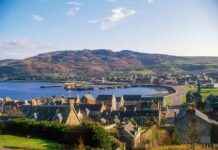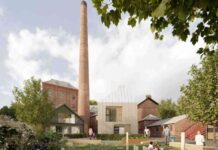Glasgow City Council has recently announced the official opening date of the long-awaited Govan-Partick Bridge, marking a significant milestone for the city. The bridge, which will link Govan and Partick, is set to open formally on Friday, September 6, with prominent ministers from both the Scottish and UK Governments, as well as the Leader of Glasgow City Council and local school children, in attendance.
The public will be able to start using the bridge from mid-morning on Saturday, September 7. This new infrastructure project is designed to improve connectivity within the city and is expected to have a positive impact on the local communities on either side of the Clyde River.
Spanning the Clyde from Water Row in Govan to Pointhouse Quay in Partick, the Govan-Partick Bridge is a key component of the city’s plans for urban development and economic growth. According to the project’s leaders, it could potentially lead to a 23% increase in accessible jobs within a 20-minute walk of Govan Cross and an 87% increase in jobs within a 10-minute cycle.
Council Leader Susan Aitken has expressed her excitement about the upcoming opening of the bridge, highlighting its significance for both Glasgow and the wider city-region. She believes that the bridge will help unlock the economic potential along the Clyde, create more opportunities for residents and workers in the area, and contribute to the ongoing transformation of Govan and Partick.
Aitken stated, “September will be a milestone in the modern history of these two great communities. It will also be a milestone for Glasgow and the wider city-region. Our riverside and the communities either side of it are home to the biggest economic opportunities in Europe, but also many of Scotland’s biggest social challenges. Reconnecting Govan and Partick can help unlock the potential along the Clyde, create more opportunities for the people who live and work there, and continue the transformation of these areas. Glaswegians often tell us how they would like to see the Clyde having a more prominent role in the life of the city. This new riverside landmark does just that.”
Following the official opening of the bridge, the city will host celebratory community events on both banks of the Clyde that weekend. The Clydebuilt Festival will take place on the north bank on September 7 and 8 beside the Riverside Museum, while the Footbridge Festival will be held on the south bank at Water Row, Govan Cross, and Govan Road on September 7.
The Govan-Partick Bridge is one of the longest opening pedestrian/cycle bridges in Europe, boasting a width of six meters and two spans. The moving span, weighing 650 tonnes and measuring 99 meters long, utilizes the South Pier at Water Row as its access point, while the fixed span, weighing 45 tonnes and measuring 15.7 meters long, complements the structure.
Originally estimated at around £10 million, the construction costs for the bridge are now projected to be just under £30 million. The project is receiving joint funding from the UK and Scottish Governments through the £1.13 billion Glasgow City Region City Deal, which aims to enhance infrastructure, drive growth in life sciences, foster business innovation, and boost employment in the region.
The partnership, signed in August 2014 by the eight member authorities along with the UK and Scottish Governments, has been instrumental in supporting projects like the Govan-Partick Bridge. The UK Government contributed £500 million, matched by the Scottish Government, with an additional £130 million provided by local authorities.
UK Government Minister for Scotland, Kirsty McNeill, emphasized the importance of the bridge in driving economic growth and fostering community development. McNeill stated, “Kick-starting growth and delivering economic stability is at the heart of the UK Government’s priorities. It’s great news for Glasgow that this UK and Scottish Government funded bridge linking Govan and Partick will soon be open, boosting the economy, bringing communities together and supporting redevelopment.”
































